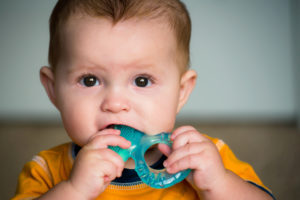
Teething is one of the great mysteries of childhood. There have been so many symptoms associated with teething over the years that at this point it can be really confusing to know when your baby is getting a tooth. At various points in time, teething has been associated with febrile illnesses, seizures and even death. With 20 teeth arriving in the first 2 years of life, it’s easy to see that there can be a lot of overlapping illnesses and behaviors that are often erroneously perceived as teething. However, with good scientific data, we now know that many things previously attributed to teething are just not true. We also know that many symptoms parents associate with teething do not predict the arrival of a tooth. At the same time, serious illnesses can be missed because the symptoms are thought to be due to teething.
What is teething and when will it happen?
Teething is the process of getting a tooth, and is actually often painless. The average age for the first tooth to appear is 4-7 months and is most often seen on the bottom gum, in the middle. A tooth eruption chart can be found here. Teeth don’t actually “cut” through the gums but they move up through a space that is created by the tissues of the gum moving out of the way. Just like when older children are getting their permanent teeth, this process is frequently not painful. In fact, the most common time to see discomfort from teething is prior to teeth coming through.
What are the symptoms of teething?
Babies who are teething may experience fussiness and drooling for 3-5 days prior to a tooth making an appearance. Sometimes the excessive drooling causes a rash on the face and chin. Babies may also put their fingers and toys in their mouths to relieve the feeling of pressure on the gums and the gums may appear swollen. Some babies may have a slightly decreased appetite but they should not stop eating altogether or become dehydrated. Babies DO NOT have fever, vomiting and diarrhea, common cold symptoms or weeks of discomfort due to teething. If you think your baby is having any of these symptoms you should seek medical care or call your pediatrician.
What should you do for teething?
Luckily, we know better about what teething is and how to treat it. For example, we no longer lance the gums to help relieve swelling, but that was routinely done in the past. Furthermore, very dangerous and toxic treatments have been used over the centuries that have now fallen out of favor. Unfortunately, there are still dangerous treatments recommended and available today that should be avoided.
•Teething Tablets: These tablets contain belladonna, which comes from a plant typically referred to as Deadly Nightshade. Belladonna affects the nervous system and can cause dry mouth and skin, dilated pupils, hallucinations, rapid heart rate and death. While belladonna is indicated for certain conditions under the name atropine, it’s use in teething tablets is not evidence-based and has come under a lot of scrutiny lately. These tablets are homeopathic, which means they are very highly diluted to the point of just being nothing. However, because homeopathic preparations are considered supplements by the FDA and not medication, they are not studied for safety and efficacy and are not regulated for consistency of concentration, dosing or quality. Therefore, it is possible to overdose on belladonna from these tablets and in fact several infant deaths have been attributed to teething tablet use. So at this time the FDA, as well as your pediatrician, is strongly cautioning against the use of these products.
•Amber necklaces: These are necklaces worn by babies in the hopes that a substance called baltic acid will be absorbed into the bloodstream and relieve teething pain. To date, there is no evidence that this actually occurs and that these necklaces actually do anything to relieve discomfort. In fact, they pose both strangulation and choking hazards so doctors strongly recommend against using them.
•Topical gels: These gels contain an ingredient called benzocaine, which is a topical anesthetic. Besides the fact that topical treatments wash away quickly rendering them ineffective in a short amount of time, they have very dangerous side effects. Benzocaine causes methemoglobinemia, which replaces normal hemoglobin in the bloodstream. Hemoglobin carries oxygen in the blood to our organs and tissues so it is vital to have normal levels of hemoglobin. When the hemoglobin is low, the oxygen is low, which can be very dangerous. Again, the FDA and the American Academy of Pediatrics do not recommend these treatments for infants.
•Acetaminophen and Ibuprofen: Oral pain reducing medications are frequently recommended for babies who are teething or in pain but I usually recommend these as a last resort. Acetaminophen can be toxic to the liver so be careful to avoid overdosing and be sure to ask your doctor about the appropriate dose for your child. Ibuprofen can irritate the lining of the stomach and can also cause damage to the kidneys, especially in children who are at risk for dehydration. Ibuprofen should never be used in babies under 6 months of age, and I actually avoid using it under 1 year because of the risks to the kidney.
•The BEST treatment: Because teething is not the prolonged excruciatingly painful process it was once felt to be, the best options to relieve discomfort are the least dangerous. Try massaging the gums with a clean finger, allowing your baby to chew on cold (not frozen) teething toys or rings, or freeze something soft, like a washcloth, for them to chew on.
If you have any concerns about your child’s symptoms, see your doctor.








Leave a Reply